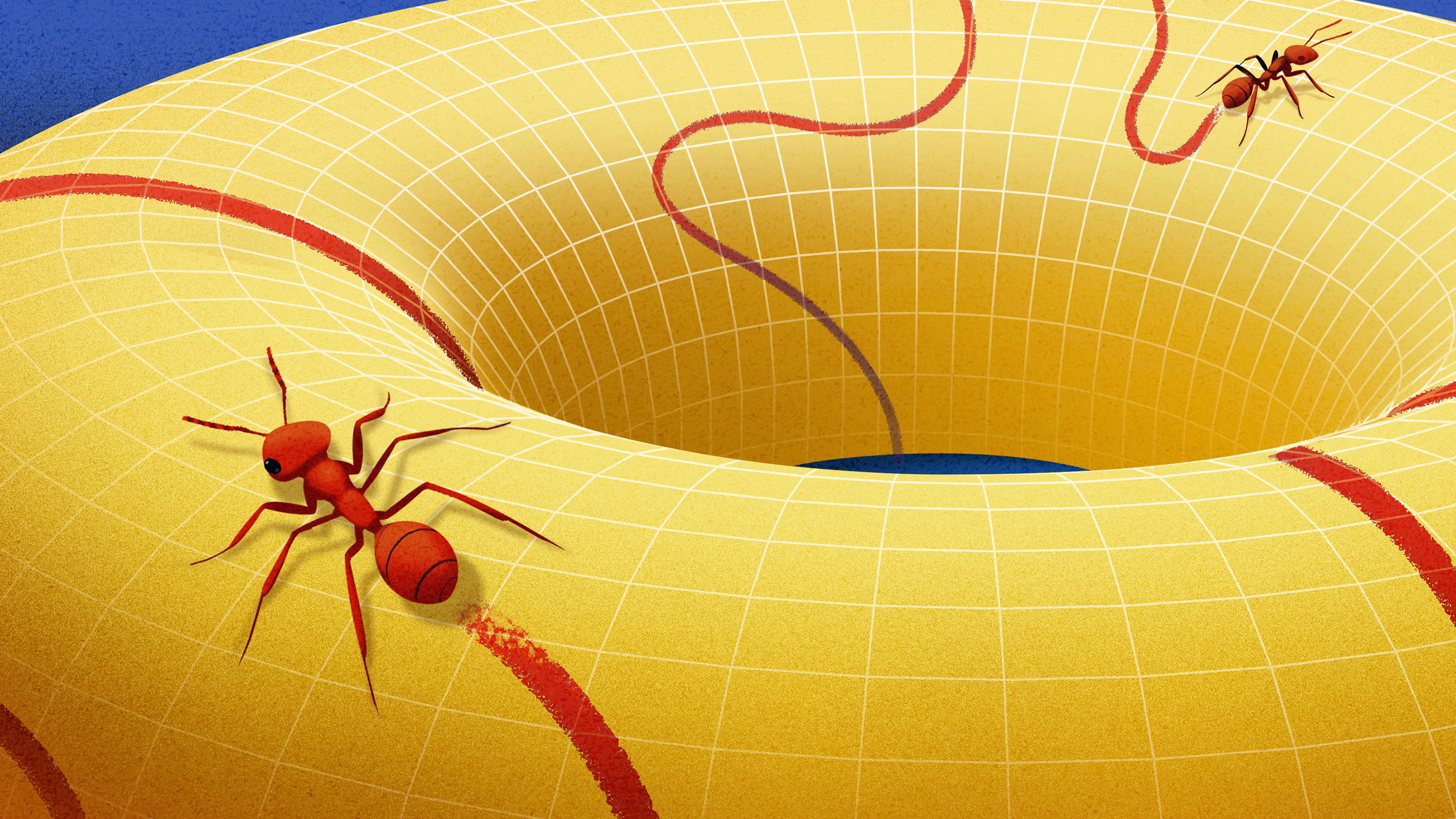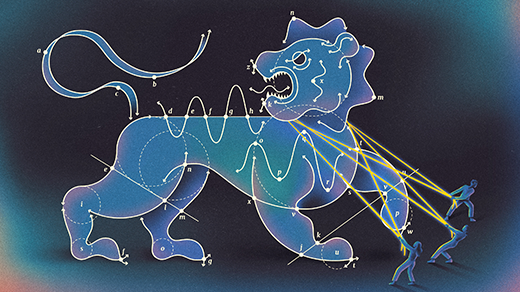What Is a Manifold?

Mark Belan/Quanta Magazine
Introduction
Standing in the middle of a field, we can easily forget that we live on a round planet. We’re so small in comparison to the Earth that from our point of view, it looks flat.
The world is full of such shapes — ones that look flat to an ant living on them, even though they might have a more complicated global structure. Mathematicians call these shapes manifolds. Introduced by Bernhard Riemann in the mid-19th century, manifolds transformed how mathematicians think about space. It was no longer just a physical setting for other mathematical objects, but rather an abstract, well-defined object worth studying in its own right.
This new perspective allowed mathematicians to rigorously explore higher-dimensional spaces — leading to the birth of modern topology, a field dedicated to the study of mathematical spaces like manifolds. Manifolds have also come to occupy a central role in fields such as geometry, dynamical systems, data analysis and physics.
Today, they give mathematicians a common vocabulary for solving all sorts of problems. They’re as fundamental to mathematics as the alphabet is to language. “If I know Cyrillic, do I know Russian?” said Fabrizio Bianchi, a mathematician at the University of Pisa in Italy. “No. But try to learn Russian without learning Cyrillic.”
So what are manifolds, and what kind of vocabulary do they provide?
Ideas Taking Shape
For millennia, geometry meant the study of objects in Euclidean space, the flat space we see around us. “Until the 1800s, ‘space’ meant ‘physical space,’” said José Ferreirós, a philosopher of science at the University of Seville in Spain — the analogue of a line in one dimension, or a flat plane in two dimensions.
In Euclidean space, things behave as expected: The shortest distance between any two points is a straight line. A triangle’s angles add up to 180 degrees. The tools of calculus are reliable and well defined.
But by the early 19th century, some mathematicians had started exploring other kinds of geometric spaces — ones that aren’t flat but rather curved like a sphere or saddle. In these spaces, parallel lines might eventually intersect. A triangle’s angles might add up to more or less than 180 degrees. And doing calculus can become a lot less straightforward.
The mathematical community struggled to accept (or even understand) this shift in geometric thinking.
But some mathematicians wanted to push these ideas even further. One of them was Bernhard Riemann, a shy young man who had originally planned to study theology — his father was a pastor — before being drawn to mathematics. In 1849, he decided to pursue his doctorate under the tutelage of Carl Friedrich Gauss, who had been studying the intrinsic properties of curves and surfaces, independent of the space surrounding them.

Bernhard Riemann is widely considered one of the greatest mathematicians in history. His work revolutionized geometry, topology, number theory and more.
Public Domain
In 1854, Riemann was required to deliver a lecture to secure a teaching position at the University of Göttingen. His assigned topic: the foundations of geometry. On June 10, despite a fear of public speaking, he described a new theory in which he generalized Gauss’ ideas about the geometry of surfaces to an arbitrary number of dimensions (and even to infinite dimensions).
Gauss was immediately impressed with the lecture, which involved not just math but also philosophy and physics. But most mathematicians found Riemann’s ideas too vague and abstract to be of much use. “Many scientists and philosophers were saying, ‘This is nonsense,’” Ferreirós said. And so, for decades, the work was largely ignored. Riemann’s lecture didn’t appear in print until 1868, two years after his death.
But by the end of the 19th century, mathematical greats like Henri Poincaré had recognized the importance of Riemann’s ideas. And in 1915, Albert Einstein used them in his general theory of relativity, bringing them out of the realm of philosophical abstraction and into the real world. By the middle of the 20th century, they had become a mathematical staple.
Riemann had introduced a concept that could encompass all possible geometries, in any number of dimensions. A concept that would change how mathematicians view space.
A manifold.
Charted Territory
The term “manifold” comes from Riemann’s Mannigfaltigkeit, which is German for “variety” or “multiplicity.”
A manifold is a space that looks Euclidean when you zoom in on any one of its points. For instance, a circle is a one-dimensional manifold. Zoom in anywhere on it, and it will look like a straight line. An ant living on the circle will never know that it’s actually round. But zoom in on a figure eight, right at the point where it crosses itself, and it will never look like a straight line. The ant will realize at that intersection point that it’s not in a Euclidean space. A figure eight is therefore not a manifold.
Similarly, in two dimensions, the surface of the Earth is a manifold; zoom in far enough anywhere on it, and it’ll look like a flat 2D plane. But the surface of a double cone — a shape consisting of two cones connected at their tips — is not a manifold.
Mark Belan/Quanta Magazine
Manifolds address a problem that mathematicians would otherwise have to deal with: A shape’s properties can change depending on the nature and dimension of the space it lives in (and how it sits in that space). For instance, lay a piece of string on a table, and connect its ends without lifting it. You’ll get a simple loop. Now hold the string in the air and tie its ends together. By considering the string in three dimensions, you can pass it over and under itself before you connect the ends, creating all sorts of knots beyond the simple loop. They all represent the same one-dimensional manifold — the looped string — but they have different properties when considered in two versus three dimensions.
Mathematicians avoid such ambiguities by focusing on the manifold’s intrinsic properties. The defining property of manifolds — that at any point, they look Euclidean — is immensely helpful on that front. Because it’s possible to think about any small patch of the manifold in terms of Euclidean space, mathematicians can use traditional calculus techniques to, say, compute its area or volume, or describe movement on it.
To do this, mathematicians divide a given manifold into several overlapping patches and represent each with a “chart” — a set of some number of coordinates (equal to the manifold’s dimension) that tell you where you are on the manifold. Crucially, you also need to write down rules that describe how the coordinates of overlapping charts relate to one another. The collection of all these charts is called an atlas.
You can then use this atlas — whose charts translate smaller regions of your potentially complicated manifold into familiar Euclidean space — to measure and explore the manifold one patch at a time. If you want to understand how a function behaves on a manifold, or get a sense of its global structure, you can break the problem up into pieces, solve each piece on a different chart, in Euclidean space, and then stitch together the results from all the charts in the atlas to get the full answer you’re seeking.
Today, this approach is ubiquitous throughout math and physics.
Manifold Uses
Manifolds are crucial to our understanding of the universe, for one. In his general theory of relativity, Einstein described space-time as a four-dimensional manifold, and gravity as that manifold’s curvature. And the three-dimensional space we see around us is also a manifold — one that, as manifolds do, appears Euclidean to those of us living within it, even though we’re still trying to figure out its global shape.
Even in cases where manifolds don’t seem to be present, mathematicians and physicists try to rewrite their problems in the language of manifolds to make use of their helpful properties. “So much of physics comes down to understanding geometry,” said Jonathan Sorce, a theoretical physicist at Princeton University. “And often in surprising ways.”
Consider a double pendulum, which consists of one pendulum hanging from the end of another. Small changes in the double pendulum’s initial conditions lead it to carve out very different trajectories through space, making its behavior hard to predict and understand. But if you represent the configuration of the pendulum with just two angles (one describing the position of each of its arms), then the space of all possible configurations looks like a doughnut, or torus — a manifold. Each point on this torus represents one possible state of the pendulum; paths on the torus represent the trajectories the pendulum might follow through space. This allows researchers to translate their physical questions about the pendulum into geometric ones, making them more intuitive and easier to solve. This is also how they study the movements of fluids, robots, quantum particles and more.
Similarly, mathematicians often view the solutions to complicated algebraic equations as a manifold to better understand their properties. And they analyze high-dimensional datasets — such as those recording the activity of thousands of neurons in the brain — by looking at how those data points might sit on a lower-dimensional manifold.
Asking how scientists use manifolds is akin to asking how they use numbers, Sorce said. “They are at the foundation of everything.”



